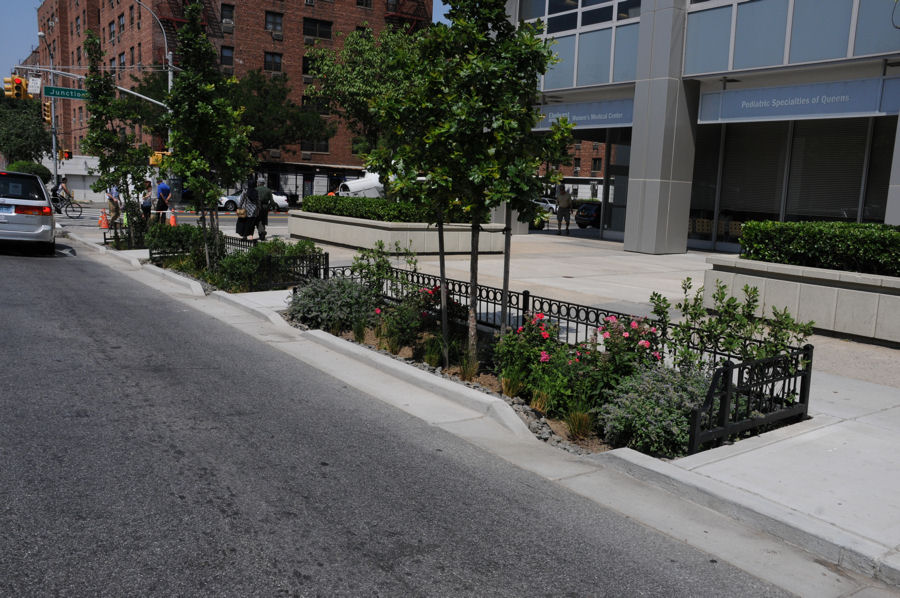
Completed rain gardens include a notch in the curb to allow stormwater to flow in and plants to beautify the garden as well as aid in evapotranspiration of the collected water. Photo credit: NYC DEP
On May 25, New York City Department of Environmental Protection (DEP) Acting Commissioner Steven Lawitts and Department of Design and Construction (DDC) Commissioner Feniosky Peña-Mora announced work has begun to build approximately 321 specially designed curbside rain gardens in the Queens neighborhoods of Sunnyside, Maspeth and Ridgewood. When construction is completed later this year, each rain garden will have the capacity to collect and absorb up to 9400 L (2500 gal) of stormwater.
Modeling shows that the rain gardens will capture an estimated 143 million L (38 million gal) of stormwater each year, reducing sewer overflows into Newtown Creek and improving the health of the waterway.
In addition, six stormwater green streets will be built to absorb stormwater in underused roadway areas. DEP is funding the $7.3 million project and the construction is being managed by DDC.
“Cleaning up Newtown Creek is a priority for DEP and we are excited that shovels are in the ground to build rain gardens in the surrounding communities,” Lawitts said.
Setting infrastructure standards
DEP developed standard designs, specifications, and procedures for building green infrastructure in the streets and sidewalks of New York City. In partnership with the New York City Department of Transportation and the Department of Parks and Recreation, DEP conducts an extensive site selection process that includes geotechnical investigations and surveys.

Each of the rain gardens will be able to absorb up to 9400 L (2500 gal) of stormwater. Photo credit: NYC DEP
During construction, the rain gardens are excavated to a depth of 1.5 m (5 ft) and then are backfilled with layers of stone and engineered soil. These layers contain void spaces that store stormwater and promote infiltration. The addition of hardy plants further encourages infiltration through root growth and increases the capacity of the rain garden through evapotranspiration.
The rain gardens are designed so that all the stormwater is absorbed in less than 48 hours and dedicated maintenance crews ensure that they function properly. The crews also remove any trash that may have accumulated and prune the trees and plants. The crews are active seven days a week, visiting each rain garden approximately once a week. Additional crews will be added as the program expands.
To date, approximately 1000 rain gardens have been built throughout New York City, 1500 currently are under construction, and thousands more are planned for the next several years.
DEP primarily builds rain gardens in neighborhoods that are serviced by combined sewers. Within these neighborhoods, locations for the rain gardens are chosen initially by DEP engineers who, armed with maps of the local sewer systems, walk the streets and identify sidewalk locations that are upstream of a catch basin and have the room necessary to accommodate a garden. This group of potential locations then is reviewed by the Department of Transportation to ensure that they meet all necessary pedestrian and vehicle clearance requirements and the Department of Parks and Recreation who provides guidance on trees and planting plans. Soil samples are taken from approved locations to ensure they can absorb the necessary amount of stormwater. The extensive survey and testing ensures that each site functions as designed. Locations that meet all these requirements will then be approved for construction.



